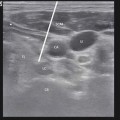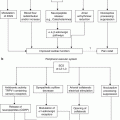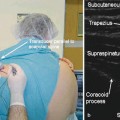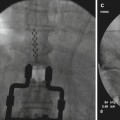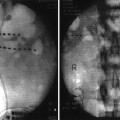Fig. 34.1
Relation of the sciatic nerve and its subdivisions to the piriformis muscle [6]. (a) The sciatic nerve exits below the piriformis muscle. (b) The sciatic nerve division passes both through and below the piriformis muscle. (c) The sciatic nerve division passes above and below the piriformis muscle. (d) The sciatic nerve passes through the piriformis muscle
Epidemiology and Pathophysiology
While an evolution of the definition of piriformis syndrome and its many etiologies has occurred, there has yet to be a clear, consensus definition. The lack of a consensus definition makes determining prevalence of piriformis syndrome difficult. Incidence rates range from 5 to 36 % of patients with buttock pain and sciatica symptoms [12]. Pace and Nagle described a 6:1 female to male ratio while others suggested a 1:1.4 female to male ratio [13, 14].
Attempts at classifying the various causes of piriformis syndrome include determining whether the symptoms are due to a primary or secondary piriformis syndrome. Primary piriformis syndrome refers to pathology intrinsic to the piriformis muscle, such as myofascial pain, pyomyositis, and myositis ossificans secondary to an inciting event such as direct trauma to the sciatic notch and gluteal region [7, 15]. This trauma may occur with prolonged sitting; prolonged and combined hip flexion, adduction and internal rotation; and certain sports activities [11, 16–18]. The latter include cyclists who ride for prolonged periods of time, tennis players who constantly internally rotate their hip with an overhead serve, and ballet dancers who constantly “turn out” or externally rotate their hip while dancing [11]. Pain may occur due to inflammatory and edematous changes in the muscle and surrounding fascia, which in turn cause a compressive neuropathy [18].
Secondary piriformis syndrome refers to all other cases in which the symptoms of posterior buttock pain and sciatica depend on the location of the pathology in relation to the structures adjacent to the sciatic notch, and includes the anatomic variations of the exiting sciatic nerve and piriformis muscle leading to sciatic nerve compression [5, 6, 15]. Such compression may occur with piriformis muscle hypertrophy, chronic inflammation, or muscle spasm which can then affect the sciatic nerve directly, especially with the nerve variations that pass through the muscle instead of beneath. Finally, secondary piriformis syndrome causes may include any lesions or structures causing a “pelvic outlet syndrome” such as pelvic tumors, endometriosis, and aneurysms or arterial malformations [15].
Clinical Examples
Diagnosis
Before the diagnosis of piriformis syndrome can be made, a broad differential should be considered in a patient presenting with sciatica. More common disorders, such as lumbar disc herniation, facet arthropathy, sacroiliitis, myofascial pain and trochanteric bursitis, can present with symptomatology similar to piriformis syndrome. There are no pathognomonic signs or symptoms, nor are there definitive laboratory tests and imaging tests that can unequivocally diagnose piriformis syndrome. However, numerous attempts have been made to describe the most common features and to provide diagnostic tools.
Symptoms and Physical Exam Findings
When he first introduced the term piriformis syndrome [7], Robinson assigned six signs and symptoms that are still widely regarded as useful today: (1) a history of trauma to the gluteal and sacroiliac regions; (2) tenderness in the region of the sacroiliac joint, greater sciatic notch, and piriformis muscle which often radiates to the hip; (3) acute exacerbations of pain with stooping or lifting and relief upon traction to the affected extremity; (4) a palpable, sausage-shaped mass over the piriformis muscle during an acute exacerbation; (5) a positive Lasègue’s sign; and (6) depending on the duration of symptoms, gluteal atrophy.
Piriformis syndrome most commonly presents with a deep, aching buttock pain on the affected side. The pain may radiate to the hip, lower back and posterior thigh but rarely below the level of the knee. Squatting, prolonged sitting, and climbing stairs often exacerbate the pain. There may also be pain with bowel movements and dyspareunia in females. In physical exam, the ipsilateral foot may be noted to lie in an externally rotated position due to a contracted piriformis muscle [12, 19–22]. A contracted piriformis muscle may be elicited as a palpable mass on rectal exam [16].
The commonly used physical exam maneuvers are described here:
Freiberg’s sign: Buttock pain with passive, forced internal rotation of the hip [2].
Pace’s maneuver: Buttock pain with resisted abduction of the affected leg while in the seated position [13].
Lasègue’s sign: Buttock pain and tenderness to palpation in the greater sciatic notch with the hip passively flexed to 90º and the knee passively extended to 180° [3].
Beatty’s maneuver: While lying in a lateral decubitus position on the unaffected side, buttock pain is elicited in the affected extremity when the patient actively abducts the affected hip and holds the knee several inches off the table [23].
FA(d)IR: An acronym for flexion, adduction, and internal rotation of the affected hip. The maneuver prolongs the H (Hoffman)-reflex on nerve conduction studies [47].
Diagnostic Tests
In addition to clinical findings, numerous diagnostic tests have been proposed to identify piriformis syndrome. However, controversy remains regarding the true utility of these studies. Imaging studies of the lumbar and pelvic region are routinely obtained and best serve to exclude other well-defined causes of buttock and radicular leg pain such as lumbar disc herniations. MRI or CT of the pelvis may reveal inflammatory changes or edema of the affected muscle. While anatomic variations of the muscle and exiting sciatic nerve may be noted, the significance of these findings is unclear. Several case reports using MRI and CT have revealed unilateral hypertrophy of the piriformis muscle on the affected side in patients with piriformis syndrome [24, 25]. A study by Filler et al. examined MR neurography showing sciatic nerve hyperintensity at the sciatic notch in patients with hypertrophy (and occasionally atrophy) noted on MRI of the affected piriformis muscle [26]. The authors concluded that this additional imaging improved the sensitivity and specificity of identifying piriformis syndrome to 64 and 93 %, respectively [26]. However, others contend numerous theoretical and methodological flaws in this study. For instance, Beatty notes that the clinical diagnostic maneuver used by Filler et al. stretches the piriformis muscle, the sciatic nerve, and stresses the sacroiliac joint and thus constitutes a nonspecific sciatic nerve test [27]. Tiel et al. challenge that although pain relief may be obtained with injection of the piriformis muscle, this does not definitively diagnose piriformis syndrome [27, 28]. Furthermore, Tiel et al. state that the Filler study did not use a gold standard against which to compare the MR neurography and, therefore, true sensitivity and specificity measurements cannot be made [28].
Electrophysiologic testing in piriformis syndrome may represent a promising diagnostic tool. Fishman et al. have described prolongation (>3SD) of the posterior tibial or peroneal H-reflexes on FA(d)IR test and purport greater than 83 % sensitivity and specificity in diagnosing piriformis syndrome [29, 30]. While this would provide an effective objective diagnostic tool, critics disagree with the diagnostic criteria and methodology used in the study [31].
Treatment
After excluding other causes of low back, sciatica, and hip pain, piriformis syndrome can be diagnosed and therapy may begin. The mainstay treatment of piriformis syndrome consists of activity modification and physical therapy, with the goals of reducing pain and spasm of the piriformis muscle and correcting the pathology of compression of the sciatic nerve (Table 34.1) [32, 33]. The patient should be provided a home therapy program that may be combined with other modalities, such as heat, ultrasound, and manual techniques. Pharmacological treatments such as nonsteroidal anti-inflammatories (NSAIDs) and muscle relaxants may compliment physical therapy programs. Fishman et al. found 79 % of patients had symptom reduction with NSAIDs, muscle relaxants, ice, and rest [30].
Table 34.1
Rehabilitation exercises for piriformis syndrome
1. Piriformis stretch: Supine position with knees flexed and feet flat on the floor. Rest the ankle of the injured leg over the knee of the uninjured leg. Grasp the thigh of the uninjured leg and pull that knee towards the chest. The patient will feel stretching along the buttocks and possibly along the outside of the hip on the injured side. Hold for 30 s. Repeat three times |
2. Standing hamstring stretch: Place the heel of the patient’s injured leg on a stool about 15 in. high. Lean forward, bending at the hips until a mild stretch in the back of the thigh is felt. Hold the stretch for 30–60 s. Repeat three times |
3. Pelvic tilt: Supine position with the knees bent and feet flat on the floor. Tighten the abdominal muscles and flatten the spine on the floor. Hold for 5 s, then relax. Repeat ten times. Do three sets |
4. Partial curls: Supine position with the knees bent and feet flat on the floor. Clasp hands behind the head to support it. Keep the elbows out to the side and do not pull with the hands. Slowly raise the shoulders and head off the floor by tightening the abdominal muscles. Hold for 3 s. Return to the starting position. Repeat ten times. Build up to three sets |
5. Prone hip extension: Prone position. Tighten the buttock muscles and lift the right leg off the floor about 8 in. Keep the knee straight. Hold for 5 s and return to the starting position. Repeat ten times. Do three sets on each side |
If conservative therapy fails to provide adequate resolution of symptoms, intramuscular piriformis muscle injections may be warranted. Numerous injection techniques have been described utilizing CT guidance, fluoroscopic guidance, ultrasound, and combined fluoroscopic and EMG guidance (Table 34.2) [17, 34, 35]. Injected medications typically consist of local anesthetic and corticosteroid. Fishman et al. described injection of 2 % lidocaine 1.5 ml and triamcinolone 0.5 ml (20 mg) in patients with clinical criteria for piriformis syndrome and prolonged H-reflex on nerve conduction studies [30]. With an average follow-up of 10.2 months, 79 % of these patients reported at least 50 % improvement in symptoms [30].
Table 34.2
Piriformis injection techniques
1. The patient is placed in a prone position |
2. The skin is prepared and draped in a sterile manner |
3. The expected position of the piriformis muscle is identified under fluoroscopic guidance with the beam directed in an anteroposterior direction. The landmarks utilized include the greater trochanter relative to the lateral border of the sacrum and sacroiliac joint on the affected side |
4. Visualize an imaginary line connecting the greater trochanter and the lower border of the sacrum |

